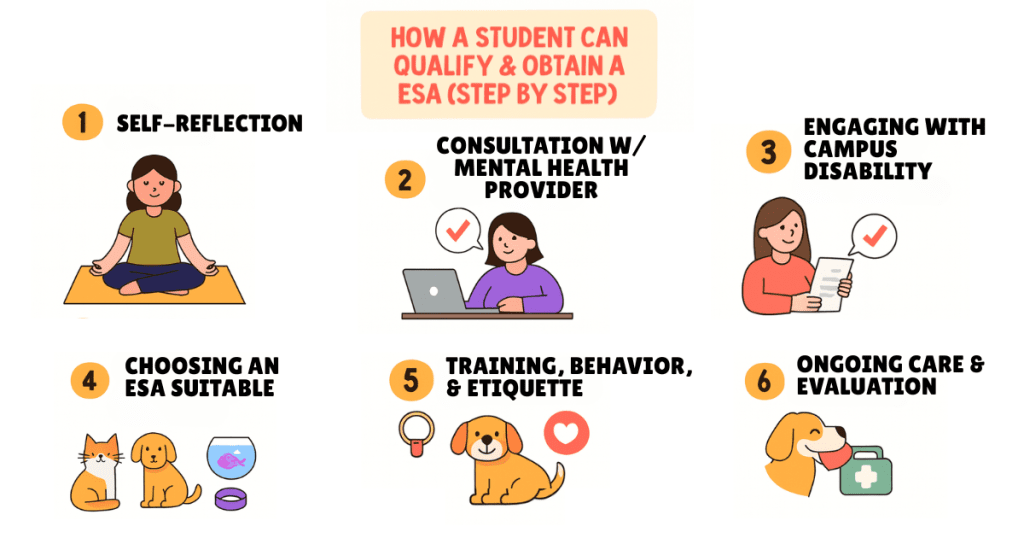College has always been a paradox: exhilarating independence coupled with crushing demands. Students often juggle academic deadlines, financial pressure, and the turbulence of early adulthood. For many, stress is not just occasional but constant, leading to anxiety that compromises both performance and well-being. Emotional Support Animals (ESAs) are emerging as a profound, if sometimes controversial, bridge between clinical care and daily resilience. By offering unconditional emotional support and a calming presence, ESAs help students manage anxiety and stress more effectively throughout college life. They are not a panacea, but when understood and applied responsibly, they can transform how students navigate campus life.
Key Takeaways
- Emotional Support Animals help college students reduce anxiety by providing comfort and stability during stressful situations.
- Research on ESAs shows promise in lowering stress hormones and improving emotional regulation, though more studies are needed.
- College housing policies protect ESA access under the Fair Housing Act, but classroom and campus access remain limited.
- Student-reported benefits of ESAs include improved routines, reduced loneliness, and stronger social connections.
- Challenges of owning an ESA in college include housing conflicts, care responsibilities, and risks of misuse with fraudulent letters.
Understanding ESAs in the Student Context

An Emotional Support Animal is not simply a pet. It is a companion prescribed by a licensed mental health professional to mitigate the effects of a psychological or emotional disability. Unlike service animals trained for tasks, ESAs are valued for their presence. Their calming influence is recognized under specific laws even though they require no specialized training. The distinction matters: service animals grant public access rights, therapy animals participate in structured programs, and ESAs function primarily as individualized, home-based support.
Legal & Policy Framework
The Fair Housing Act (FHA) requires universities and landlords to allow ESAs in otherwise pet-free housing, provided the student presents legitimate documentation.
- Section 504 of the Rehabilitation Act adds another safeguard by prohibiting discrimination against students with qualifying disabilities.
- Americans with Disabilities Act (ADA) exclusion: ESAs remain outside ADA protections, so students cannot expect to bring them into classrooms, libraries, or dining halls.
- Airline policies have shifted, with most carriers limiting ESA recognition in travel.
Together, this patchwork of rules reflects broader debates about where therapeutic support ends and unrestricted access begins.
Common Misconceptions & Myths
- “Just pets” myth: Many assume ESAs are no different from household pets. This view dismisses the therapeutic intent and legal status attached to them.
- Fraudulent letters: Some exploit loopholes by ordering fake ESA letters online, undermining genuine cases and complicating enforcement for institutions.
- Unlimited access belief: Another myth suggests ESAs automatically belong everywhere, such as classrooms, labs, or cafeterias. In reality, the law is far more restrictive.
Why clarity matters: Addressing these misconceptions helps balance the rights of ESA owners with the legitimate concerns of others who share the same environment.
The Current Research Landscape
Research on ESAs is both promising and fragmented. Longitudinal studies show decreased cortisol levels and improved affect regulation in students who regularly interact with animals. Qualitative interviews capture stories of relief from loneliness, stabilization of routines, and increased motivation.
Still, scholars highlight limitations: small sample sizes, reliance on self-reports, and lack of randomized trials. The evidence base is growing but remains less rigorous than for established clinical interventions. This gap leaves universities hesitant, supporting ESA use while cautiously demanding stronger data.
How ESAs Help with Anxiety & Stress: Mechanisms & Benefits

Psychological and Physiological Pathways
Animals offer more than comfort. They change chemistry. Interactions with ESAs lower cortisol and adrenaline, blunt the edge of stress, and increase oxytocin, which fuels bonding and calm. Students often describe feeling “safe” or “grounded” around their ESA. Attachment theory explains this: the animal becomes a secure base, buffering external chaos with predictable affection.
Student-Reported Themes from Qualitative Studies
Across interviews, four themes surface. The “presence of the animal” itself becomes a stabilizer during panic or insomnia. Many report “empowerment” from caring for a dependent creature, reversing the helplessness of anxiety. “Symptom alleviation” is real, with students mentioning fewer anxious episodes and less loneliness. And in some cases, ESAs act as “social catalysts,” sparking conversations in dorms or on walks that students might otherwise avoid.
Secondary Benefits that Support Stress Management
Owning an ESA introduces structure. Feeding times, walks, and vet visits compel routine. This rhythm curbs chaotic schedules notorious in college life. Physical activity, whether walking a dog or playing with a cat, provides built-in exercise. The animal’s unconditional presence also anchors students during finals, breakups, or homesickness. Even subtle nudges, like waking up earlier to feed a pet, contribute to healthier habits that indirectly reduce stress.
Case Vignettes / Mini-Stories
Consider a student battling generalized anxiety. She reports her ESA cat curling beside her during panic attacks, slowing her breathing and calming her. Another student describes how taking his ESA dog for walks during finals became a ritual that transformed study breaks into recovery moments. These vignettes echo research findings yet resonate more deeply because they illustrate lived reality. An ESA can shift the daily experience of college stress in ways medication or therapy alone sometimes cannot.
Challenges, Risks & Counterarguments
Behavioral, Hygiene, and Care Issues
Not every ESA story is rosy. Some students underestimate the commitment, leading to neglected care. Barking, shedding, or allergies may strain dorm life. Veterinary costs add another stressor. Inconsistent care can even harm the animal, raising ethical concerns.
Housing and Roommate Conflicts
Roommates may be allergic, fearful, or simply unwilling to share a small dorm with an animal. Disclosure of one’s mental health status can become unavoidable, leaving students vulnerable. Universities often resolve conflicts by reassigning housing, but this can displace both ESA owners and their peers.
Institutional Resistance & Policy Ambiguity
Universities struggle with ESA requests. Policies vary widely, with some schools having detailed processes and others none at all. Misinterpretation is common: students assume ESAs can accompany them anywhere, while administrators worry about liability. Without clarity, both sides clash.
Ethical Concerns & Misuse
Fraudulent ESA letters purchased online erode trust. Mental health professionals themselves face dilemmas: should they approve a request based on limited evidence, or deny it and risk worsening a student’s condition? The lack of robust data amplifies the ethical tension.
Limitations of Benefits
An ESA is not a cure-all. Short-term comfort may not translate into long-term resilience. Without therapy or other interventions, root causes of anxiety remain untreated. Students sometimes place unrealistic expectations on their ESA, setting themselves up for disappointment.
How a Student Can Qualify & Obtain an ESA (Step-by-Step)

Step 1: Self-Reflection & Exploring Alternatives
Before seeking an ESA, students should evaluate whether their needs might be met through counseling, peer groups, or mindfulness practices. ESAs are not entry-level solutions; they are commitments that require readiness.
Step 2: Consultation with Mental Health Provider
A licensed provider must diagnose or confirm a condition that significantly impairs daily life. They evaluate severity, history, and functional limitations. A legitimate ESA letter is not generic; it is tailored, specific, and issued after a thorough assessment.
Step 3: Engaging with Campus Disability / Housing Office
Students must submit documentation, often with deadlines tied to housing assignments. Disability offices balance student needs with institutional policies. Appeals exist for denied requests, but transparency in paperwork often makes the process smoother.
Step 4: Choosing an ESA Suitable for Campus Life
Not every animal adapts to dorms. Cats, small dogs, rabbits, or even fish are often better suited than high-energy breeds. Noise, size, and maintenance all matter. Selecting wisely prevents future conflicts.
Step 5: Training, Behavior, and Etiquette
Even though training is not legally required, universities expect well-behaved animals. Basic obedience, socialization, and predictability reduce complaints. Students must also prepare for breaks, knowing where the animal will stay during travel or holidays.
Step 6: Ongoing Care & Evaluation
Regular vet visits, grooming, and health monitoring ensure the ESA’s welfare. Students should periodically reassess: is the ESA still meeting its intended purpose? If not, making a change may be necessary for both student and animal.
Practical Tips & Best Practices for Students & Institutions

For Students
- Communicate openly with roommates before moving in.
- Keep ESA letters and renewals organized.
- Join peer groups or online communities for ESA owners.
- Plan for travel, breaks, and emergencies.
- Remember: ESAs help, but they are not magic fixes.
For Universities / Housing Offices
- Draft clear, public ESA policies.
- Train staff to handle requests with consistency.
- Develop conflict resolution pathways.
- Provide education about ESA rights and limits.
- Pilot new initiatives, like designated ESA-friendly dorms.
For Mental Health Providers
- Follow ethical guidelines when writing ESA letters.
- Document clinical reasoning thoroughly.
- Know when to recommend alternatives.
Integration with Other Support Strategies
ESAs shine brightest when paired with broader support. Therapy, counseling, and medication remain essential for many students. Universities also experiment with wellness programs such as drop-in therapy dogs before exams, mindfulness workshops, or resilience training. Peer support networks add another dimension, while academic accommodations like flexible deadlines address structural barriers. The synergy of these interventions makes ESA use less about replacement and more about reinforcement.
Measuring & Evaluating Impact
Recommended Metrics & Scales
Tracking impact is critical. Tools like the GAD-7 for anxiety or Beck’s Depression Inventory provide benchmarks. Stress scales and quality-of-life surveys offer broader insights. Collecting roommate feedback can reveal secondary effects, both positive and negative.
Suggested Research Designs for Future Studies
To solidify ESA legitimacy, researchers call for randomized controlled trials, longitudinal studies, and mixed-method designs across multiple campuses. These approaches could measure both biochemical shifts and narrative experiences.
Case Studies: Example Campus Programs
Some universities already run structured ESA programs, offering staff support and behavior guidelines. These initiatives provide valuable data while reducing conflict, creating templates other institutions can replicate.
Beyond the Conclusion: A Path Forward
At Emma and Buddy, we have seen that Emotional Support Animals are neither cure-alls nor frivolous luxuries. They are nuanced interventions that deserve careful thought. For students, they can turn anxiety into something manageable, transform loneliness into connection, and reshape stress into routine.
For institutions, they present logistical and ethical challenges that demand clarity and compassion. The next chapter is not only about proving that ESAs work, but about integrating them responsibly into the larger ecosystem of student mental health. In this balance lies the real potential of ESAs to reshape how we understand and support college well-being, and this is where we stand firm in our commitment.













